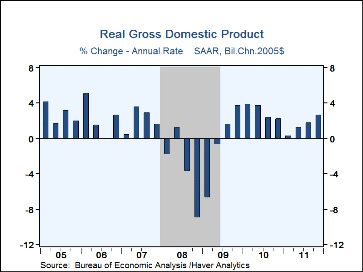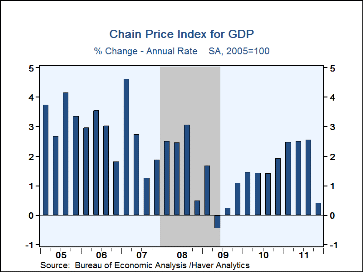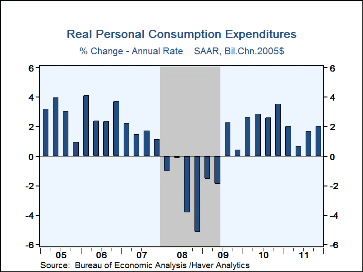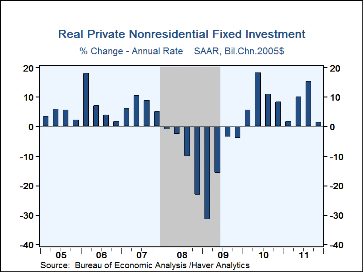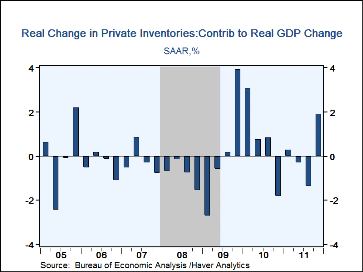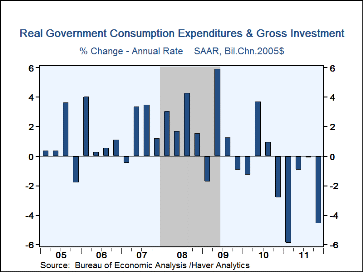 Global| Jan 27 2012
Global| Jan 27 2012U.S. GDP Growth Is Strongest Since Q2'10 But Misses Expectations
by:Tom Moeller
|in:Economy in Brief
Summary
Economic growth returned to its trend last quarter, but no more. In its advance estimate the Commerce Department indicated that Q4'11 real GDP grew at a 2.8% annual rate. Expectations had been for a 3.0% rise. The figure was improved [...]
Economic growth returned to its trend last quarter, but no more. In its advance estimate the Commerce Department indicated that Q4'11 real GDP grew at a 2.8% annual rate. Expectations had been for a 3.0% rise. The figure was improved versus Q1 and the strongest since Q2'10. However, the gain was only back to its trend. Typical for the early stages of postwar growth following recessions is a sharp bounce-back, particularly from an economic downturn as deep as the last.
A 1.9 percentage point contribution to growth from inventory accumulation was the standout behind last quarter's GDP increase. That rise followed a subtraction from growth during three of the prior four quarters. Foreign trade subtracted 0.1 point from growth as exports rose at a 4.6% rate (5.2% y/y) and imports rose 4.4% (3.8% y/y).
Poor domestic final sales growth of 0.9% (1.3% y/y) reflected across-the-board weakness. Notable was a 4.6% decline (-2.9% y/y) in government spending that centered on a 12.5% drop (-3.7% y/y) in defense outlays. Spending by state & local governments also fell at a 2.6% rate (-2.6% y/y), constrained by falling tax revenues.
Growth in personal consumption expenditures of 2.0% (1.6% y/y) was still below its trend and the weakest gain since Q1'10. Goods consumption grew at a respectable 5.7% rate (2.5% y/y), fueled by a one-third gain in spending of motor vehicles. Growth in spending on other durables also was firm. However, consumption weakness elsewhere reflected spending on nondurables which grew a modest 1.6% (0.7% y/y). Also, services consumption edged up just 0.2% (1.2% y/y), held back by a 3.1% decline (-0.3% y/y) in housing & utilities. Business fixed investment grew at a reduced 1.7% rate (7.3% y/y) and was reduced by a 7.2% decline (+2.7% y/y) in structures. Spending on equipment & software rose at a moderate 5.2% rate (9.0% y/y) but that was its weakest increase of the economic recovery. Residential investment was the standout to the upside with a 10.9% rise (3.3% y/y). That was the strongest increase since Q2'10 when growth was fueled by a government subsidy.
Price inflation remained very much under control as indicated by the 0.4% gain in the chain GDP price index. That was down from a Q3 rise of 2.6% and was the weakest since Q3'09. The increase reflected across-the-board price moderation and compared to expectations for a 1.5% rise.
The latest GDP figures can be found in Haver's USECON and USNA databases; USNA contains basically all of the Bureau of Economic Analysis' detail on the national accounts, including the new integrated economics accounts and the recently added GDP data for U.S. Territories. The Consensus estimates can be found in AS1REPNA.
IMF Marks Down Global Growth Forecast, Sees Risks on Rise from the International Monetary Fund is available here.
| Chained 2005 $, % AR | Q4'11 (Adv) | Q3'11 | Q2'11 | Q4'11 Y/Y |
2011 | 2010 | 2009 |
|---|---|---|---|---|---|---|---|
| Gross Domestic Product | 2.8 | 1.8 | 1.3 | 1.6 | 1.7 | 3.0 | -3.5 |
| Inventory Effect | 1.9 | -1.4 | -0.3 | 0.2 | -0.2 | 1.6 | -0.9 |
| Final Sales | 0.8 | 3.2 | 1.6 | 1.4 | 1.9 | 1.4 | -2.6 |
| Foreign Trade Effect | -0.1 | 0.4 | 0.2 | 0.1 | 0.1 | -0.4 | 1.0 |
| Domestic Final Sales | 0.9 | 2.7 | 1.3 | 1.3 | 1.8 | 1.8 | -3.6 |
| Demand Components | |||||||
| Personal Consumption | 2.0 | 1.7 | 0.7 | 1.6 | 2.2 | 2.0 | -1.9 |
| Business Fixed Investment | 1.7 | 15.7 | 10.3 | 7.3 | 8.6 | 4.4 | -17.9 |
| Residential Investment | 10.9 | 1.2 | 4.2 | 3.3 | -1.4 | -4.3 | -22.2 |
| Government Spending | -4.6 | -0.1 | -0.9 | -2.9 | -2.1 | 0.7 | 1.7 |
| Chain-Type Price Index | |||||||
| GDP | 0.4 | 2.6 | 2.5 | 2.0 | 2.1 | 1.2 | 1.1 |
| Final Sales of Domestic Product | 0.4 | 2.6 | 2.5 | 2.0 | 2.0 | 1.2 | 1.0 |
| Final Sales to Domestic Purchasers | 0.8 | 2.0 | 3.4 | 2.5 | 2.4 | 1.5 | -0.1 |
Tom Moeller
AuthorMore in Author Profile »Prior to joining Haver Analytics in 2000, Mr. Moeller worked as the Economist at Chancellor Capital Management from 1985 to 1999. There, he developed comprehensive economic forecasts and interpreted economic data for equity and fixed income portfolio managers. Also at Chancellor, Mr. Moeller worked as an equity analyst and was responsible for researching and rating companies in the economically sensitive automobile and housing industries for investment in Chancellor’s equity portfolio. Prior to joining Chancellor, Mr. Moeller was an Economist at Citibank from 1979 to 1984. He also analyzed pricing behavior in the metals industry for the Council on Wage and Price Stability in Washington, D.C. In 1999, Mr. Moeller received the award for most accurate forecast from the Forecasters' Club of New York. From 1990 to 1992 he was President of the New York Association for Business Economists. Mr. Moeller earned an M.B.A. in Finance from Fordham University, where he graduated in 1987. He holds a Bachelor of Arts in Economics from George Washington University.


